

Organovo Has Its First Commercial 3D Bioprinter. 3D bioprinters could one day construct an organ from your own cells as easily as you print a map.

(Artist's rendering) Need a new kidney? We’ll just take some of your blood and in about six weeks grow you a new one. That’s the promise of 3D bioprinting and one of the companies on the forefront of the technology just took a step closer to make it a reality. Organovo developed a research prototype of a bioprinter capable of producing very basic tissues like blood vessels.
When it comes to bioprinting, Organovo isn’t the only name in the game. Organovo’s commercial version of the 3D bioprinter comes with some nice bells and whistles. Yet as fancy as the printer may be, the real test for Organovo isn’t the machine, but what the machine produces. The Next Battle for Internet Freedom Could Be Over 3D Printing. Editor’s note: Rick Kelly (@_rickkelly) is an adjunct political science professor at BYU-Idaho and MBA student at UNC-Chapel Hill.
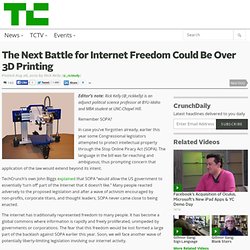
Remember SOPA? In case you’ve forgotten already, earlier this year some Congressional legislators attempted to protect intellectual property through the Stop Online Piracy Act (SOPA). The language in the bill was far-reaching and ambiguous; thus prompting concern that application of the law would extend beyond its intent. TechCrunch’s own John Biggs explained that SOPA “would allow the US government to essentially ‘turn off’ part of the Internet that it doesn’t like.” 3D Printing: Rise of the machines. News - 3D printers could create customised drugs on demand.
18 April 2012Last updated at 12:32 ET The team used a 3D printer to create "reactionware" capable of producing chemical compounds Scientists are pioneering the use of 3D printers to create drugs and other chemicals at the University of Glasgow.
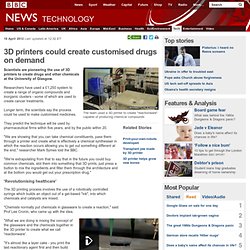
Researchers have used a £1,250 system to create a range of organic compounds and inorganic clusters - some of which are used to create cancer treatments. Longer term, the scientists say the process could be used to make customised medicines. They predict the technique will be used by pharmaceutical firms within five years, and by the public within 20. "We are showing that you can take chemical constituents, pass them through a printer and create what is effectively a chemical synthesiser in which the reaction occurs allowing you to get out something different at the end," researcher Mark Symes told the BBC. 'Revolutionising healthcare'
Les femmes vont adorer les imprimantes 3D. L’impression 3D est-elle le moteur de la fabrication de demain. 2012 a Big Year for MakerBot – New 3D Printer, $Millions in Funding, and Huge Growth Ahead. The Replicator is MakerBot's latest, greatest desktop device with two color printing, 5 liters of printing volume, and a price tag ($1999) that may make it ideal for the classroom.
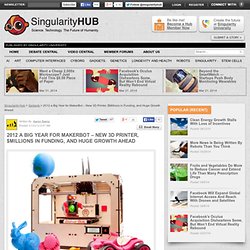
Three years ago they had three employees and were still trying to keep their equipment from breaking down. Now MakerBot employs 75, has millions in funding, and 7500+ of their printers in use. The Brooklyn-based company is the epitome of a successful tech startup, all the more remarkable because their devices are completely open source hardware – free for anyone to build or modify on their own. MakerBot hopes to continue their phenomenal growth of the past few years by starting off 2012 with a bang. 3D Printing is a billion dollar industry and is almost ready to explode into the mainstream. Technology Review - With 3-D printing, manufacturers can make existing products more efficiently—and create ones that weren't possible before Technicians at General Electric weld together as many as 20 separate pieces of metal to achieve a shape that efficiently mixes fuel and air in a fuel injector.
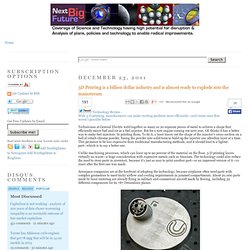
But for a new engine coming out next year, GE thinks it has a better way to make fuel injectors: by printing them. To do it, a laser traces out the shape of the injector's cross-section on a bed of cobalt-chrome powder, fusing the powder into solid form to build up the injector one ultrathin layer at a time. This promises to be less expensive than traditional manufacturing methods, and it should lead to a lighter part—which is to say a better one. Could 3D printing end our throwaway culture? There's a tiny knob missing from my hands-free car kit, which I keep meaning to replace.
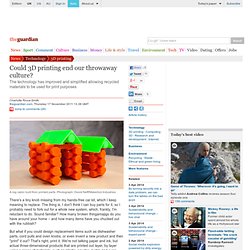
The thing is, I don't think I can buy parts for it, so I probably need to fork out for a whole new system, which, frankly, I'm reluctant to do. Sound familiar? How many broken thingamajigs do you have around your home – and how many items have you chucked out with the rubbish? But what if you could design replacement items such as dishwasher parts, cord pulls and oven knobs, or even invent a new product and then "print" it out? That's right, print it. While you're just processing that concept, let me take you back to the early days of 3D printing, because although this technology may be new to you, major manufacturers have been using it for decades. As with all new technologies, the early adopters were those with the most cash to splash. "3D printing in general has been around since 1986 or thereabouts," says Jake Durrant, senior lecturer at Ravensbourne digital design college. Proscribed Printables.
Interesting milestone in open-source 3D printing over at Thingiverse: User crank has published a freely-downloadable magazine for the ubiquitous AR-15 rifle.
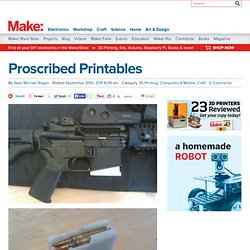
As downloaded, crank’s magazine only holds five rounds, but a person with basic 3D modelling skills could modify it with little difficulty to produce a “high-capacity” magazine. I’m not sure what the current state of law on magazine size limits is, but prior to the sunset of the Federal Assault Weapons Ban (Wikipedia) in 2004, manufacture of an AR-15 magazine with a capacity of more than 10 rounds was an offense. Imprimer le réel à portée de main. L'impression 3D déjà à la portée de tous avec Blender et Shapeways.
Les imprimantes d'objets en 3D ont leur première affaire de piratage. Vidéo : L'impression 3D pour les... enfin ceux qui ne connaissent pas bien. 3D Printing, Intellectual Property, and the Fight Over the Next Great Disruptive Technology. It is critical for today’s 3D printing community, tucked away in garages, hackerspaces, and labs, to keep a vigilant eye on these policy debates as they grow.

There will be a time when impacted legacy industries demand some sort of DMCA for 3D printing. If the 3D printing community waits until that day to organize, it will be too late. Instead, the community must work to educate policy makers and the public about the benefits of widespread access. The next Napster? Copyright questions as 3D printing comes of age. The Penrose Triangle is as elegant as it is impossible—much like M.C.
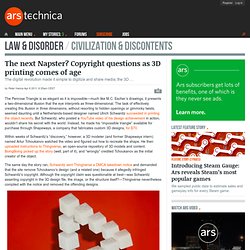
Escher’s drawings, it presents a two-dimensional illusion that the eye interprets as three-dimensional. The task of effectively creating this illusion in three dimensions, without resorting to hidden openings or gimmicky twists, seemed daunting until a Netherlands-based designer named Ulrich Schwanitz succeeded in printing the object recently. But Schwanitz, who posted a YouTube video of his design achievement in action, wouldn’t share his secret with the world. Instead, he made his “impossible triangle” available for purchase through Shapeways, a company that fabricates custom 3D designs, for $70. Within weeks of Schwanitz’s “discovery,” however, a 3D modeler (and former Shapeways intern) named Artur Tchoukanov watched the video and figured out how to recreate the shape.
“For better or worse,” Thingiverse founder Bre Pettis wrote on the site’s blog, “we’ve hit a milestone in the history of digital fabrication.” L'impression 3D, ce sera formidable... s'ils ne foutent pas tout en l'air ! L’impression 3D est en train de naître sous nos yeux.

Demain il sera ainsi possible de reproduire toute sorte d’objets chez nous aussi facilement, ou presque, qu’un texte numérique se couche sur le papier à l’aide de notre bonne vieille imprimante 2D. Les conséquences potentielles de la démocratisation d’un tel outil donnent le vertige et suscitent espoir et enthousiasme parmi les makers du monde entier[1] Technology: Print me a Stradivarius. THE NEXT TRILLION DOLLAR INDUSTRY: 3D Printing. 3-D Brings a Wow Factor to Printing. Printing body parts: Making a bit of me. Additive Manufacturing company Stratasys and Kor Ecologic of Winnepeg, Canada make Urbee , the first 3D printed car. Imprimantes 3D. 3D Printing. Feed a device with blueprints for a solid object of your choosing, then let the machine build it for you from plastic or other simple materials [1] Video illustration at "3D Printing” is an umbrella term that covers four distinct manufacturing technologies.
All are “Additive Fabrication” processes that create objects by adding material in thin layers until a product is completed. Each technology addresses the challenge differently with accompanying benefits and drawbacks. Naissance du Fabernet. La fabrication numerique by Jean-Michel Cornu on Prezi. Term Wars: 3D-Printing, Additive Fabrication, Fabbing, Rapid Manufacturing, Layered Manufacturing - Mass Customization. Zapfab: User-generated content meets 3D Printing - Mass Customization. A new Ponoko-alike company is coming from Manchester in the UK! Zapfab Ltd is a user manufacturing start up that offers a new way of delivering individualized, customized products. As other companies in this field, they are combining the creativity of user-generated content with the power of 3D Printing (fabbing). In a press release I got today, the company is described as follows: "User-generated content is ubiquitous throughout the internet, from weblogs to YouTube videos.
RepRap.org. RepRap is humanity's first general-purpose self-replicating manufacturing machine. RepRap takes the form of a free desktop 3D printer capable of printing plastic objects. Since many parts of RepRap are made from plastic and RepRap prints those parts, RepRap self-replicates by making a kit of itself - a kit that anyone can assemble given time and materials. It also means that - if you've got a RepRap - you can print lots of useful stuff, and you can print another RepRap for a friend... RepRap is about making self-replicating machines, and making them freely available for the benefit of everyone. We are using 3D printing to do this, but if you have other technologies that can copy themselves and that can be made freely available to all, then this is the place for you too.
Reprap.org is a community project, which means you are welcome to edit most pages on this site, or better yet, create new pages of your own. New 3D Printer: The Thing-O-Matic! - MakerBot Industries. EmailShare 580EmailShare. Hacker en sous-sol. Houellebecq et les Fab Labs » Article » OWNI, Digital Journalism. Xavier de la Porte, producteur de l'émission Place de la toile sur France Culture, revient sur le dernier ouvrage de Michel Houellebecq "La Carte et le territoire" sous l'angle des technologies.
Vers des objets open-source » Article » OWNI, Digital Journalism. Et si on appliquait aux objets bien matériels les règles des logiciels open-source, en rendant accessible les processus de fabrication, en libérant la distribution, la fabrication et la copie ? Un projet pas si fou que ça. Depuis quelques mois maintenant se joue une guerre passionnante (à plus d’un titre), qui risque bien de révolutionner le monde de l’électronique et de l’informatique tel que nous le connaissons aujourd’hui, avec l’avènement d’un mouvement qui sera difficilement stoppé, celui de l’OpenSource Hardware (ou Matériel OpenSource, que nous résumerons par HSW).
3D printer to churn out copies of itself - tech - 18 March 2005. A self-replicating 3D printer that spawns new, improved versions of itself is in development at the University of Bath in the UK. The "self replicating rapid prototyper" or RepRap could vastly reduce the cost of 3D printers, paving the way for a future where broken objects and spare parts are simply "re-printed" at home. New and unique objects could also be created. La révolution dans un garage, encore. Durant les années 1970, quelques geeks décidèrent que nous disposerions tous d’une puissance de calcul digne des plus grandes multinationales ou organisations gouvernementales. RepRap, la machine réplicante qui fait peur aux capitalistes. Create It Real. Passionate about creating. Put your feet up, Santa, the Christmas machine has arrived. The following correction was printed in the Guardian's Corrections and clarifications column, Friday December 8 2006 Project Gutenberg, the online repository of e-books mentioned in the article below, has more that 100,000 entries, rather than the 19,000 e-books stated.
3-D Printing Is Spurring a Manufacturing Revolution.